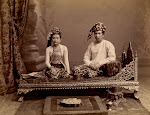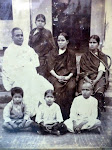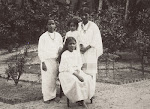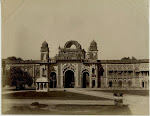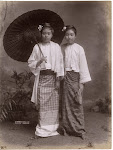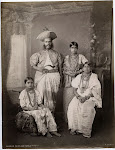Published in Mizzima Business Weekly on 11 February 2014

Burmese Minister in court dress – Photo by J. Jackson
Rare images of 19th century Burma pique interest of young and old
The first public exhibition featuring photographs of 19th century Myanmar is taking place in downtown Yangon until February 28.
The event is being co-hosted hosted by the Yangon Heritage Trust,
which says the rare photographs have already generated an encouraging
amount of interest, including among Yangon residents.
“One man brought his children back with him on his second visit,
because they didn’t believe that ministers actually used to wear such
grand costumes made of gold and velvet – they’d only seen it in the
movies,” said Shwe Yinn Mar Oo, the trust’s senior communications
officer.
She added that Transport Ministry personnel have visited the
exhibition to see a rare photograph of one of the vessels owned by the
Irrawaddy Flotilla Company, which at its peak in the 1920s operated the
largest fleet of river boats in the world. The Scottish-owned company
operated from 1865 until 1948, when it was reconstituted as the
state-run Inland Water Transport Board after Burma’s independence from
Britain.

An Irrawaddy Flotilla vessel in Rangoon – Photo by Felice Beato
The exhibition features 44 photographs from a collection of 100 owned
by a Yangon-based French businessman, Gilles de Flogny. The exhibition,
which is being co-hosted by the trust and the Italian embassy, features
the work of three photographers.
“The photographs are a window into our past that will help us
understand our present, and perhaps even tell us something about our
future. They include many portraits and show Myanmar in all its
wonderful diversity,” said Dr Thant Myint-U, the trust’s founder and
chairperson.
As well as depicting another era, when the country was under siege
from Britain and undeveloped – as the photograph of a lonely-looking
Sule Pagoda demonstrates – some aspects of life remain unchanged to the
present day.
In “Burmese Beauty” by Felice Beato, which is also featured on the
cover of the modern Penguin edition of George Orwell’s novel, Burmese
Days (1934), the motifs on the young woman’s silk lungyi remains popular
among Myanmar women today, along with the padauk flowers worn in their
hair, said Shwe Yinn Mar Oo. The extra reams of fabric worn by women
during ceremonial occasions, however, were perhaps jettisoned for
practical purposes.

Burmese Lady by J. Jackson
Exhibition visitor, Gon Lynn Htun, who previously worked as a
translator for the US embassy, the ornate costume depicted in a
photograph by J. Jackson was worn by ministers for centuries until King
Thibaw, Myanmar’s last monarch, was exiled to India by the British after
they captured Mandalay Palace in 1885.
“Despite being laden with gold, the traditional attire wasn’t overly
heavy. Around the time this picture was taken [of the minister] and when
Lower Burma had been annexed to the British, Burma had sent several
ambassadors and plenipotentiaries to France. You could say that the
Kingdom of Burma was flirting with France, and it made the British very
uneasy,” Gon Lynn Htun said.
“I’m extremely interested in Burmese attire and I have my own archive
of photographs at home –they are mostly pictures of my great, great
grandparents and many of the photos are more than a hundred years old,”
he told Mizzima Business Weekly.
For several decades spanning the 19th and 20th centuries,
photographer Klier owned studios in Mawlamyine and Yangon, and due to
the reputation he acquired during his time in Japan as a portrait
photographer, he attracted an impressive clientele of wealthy Myanmar,
who commissioned him to take official portraits.
Another of the photographers featured in the exhibition,
Italian-British citizen Felice Beato, had a studio in Mandalay, in
addition to running a highly profitable antiques shop. He is widely
regarded as being the first war photographer and one of the first
photographers in East Asia. Little is known about the third photographer
featured in the exhibition, J. Jackson.

Sule Pagoda – Photo by J.Jackson
Shwe Yinn Mar Oo told Mizzima Business Weekly that although visitors
from a range of age groups had seen the exhibition by the time it neared
its second week, it was attracting only about 25 visitors a day,
including Myanmar and foreigners.
“The tragedy is that young people aren’t interested in Burmese
history and culture – they are fascinated with Western and South Korean
cultures,” said Gon Lynn Htun.
“Most young people simply want to leave Myanmar to earn a better
salary abroad – this is their main priority because our country was kept
in the dark for so long and opportunities here are still very limited.
It’s only the scholarly types, which constitute a very small minority,
who will come [to this exhibition] and who are interested in Myanmar’s
past,” he said.

Minister in Court Dress and Servant – Photo by J. Jackson
Although the photo captions are disappointing because they contain
little information about the subject or the photographer, and no
background information about Myanmar’s place in history during the 19th
century, the exhibition certainly takes an important first step in what
may be a long process of reviving interest in Myanmar’s fascinating
past.
The exhibition is open to the public until February 28.
Tickets are US$3. Yangon Heritage Trust is on the first floor of 22
Pansodan Street (lower block), in Kyauktada Township, Yangon. For more
information, visit yangonheritagetrust.org
Yangon Heritage Trust should also be applauded for using
social media to engage with the younger generation – an even wider
collection of photographs is posted on the trust’s Facebook page, which
can be viewed at facebook.com/theyangonheritagetrust
http://jessicamudditt.com/2014/02/18/window-to-the-past-19th-century-burma-in-pictures/

